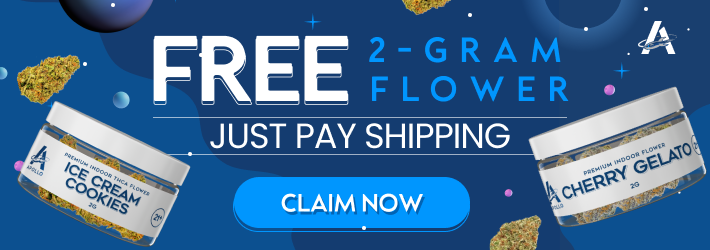Key Takeaways:
- Myrcene is an abundant terpene that gives mangoes their famous aroma and is found in the majority of cannabis cultivars.
- Indica fans are pleased to know myrcene is the key ingredient that causes “couch lock” and more “stoney” sedative effects.
- People often eat mangoes to get higher from cannabis. This works because the myrcene boost from mangoes may help cannabinoids cross the blood-brain barrier, delivering more medicine where it’s needed.
Characteristics of Myrcene
Ever wonder what makes a mango smell like a mango? It’s largely from the richness of a terpene called myrcene, which can also be abundantly found in Cannabis. Its complex scent is a mixture of berries, herbs, spice, wood, flowers, and root vegetables.
Myrcene is one of tens of thousands of fragrant, organic compounds called terpenes.
Besides mangoes, you can get myrcene naturally from:
- Hops
- Lemongrass
- Basil
- Bay leaves
- Citrus fruits and juices
Plants make myrcene because it’s good at keeping away pests and parasites for them, while attracting beneficial pollinators.
It also gives plants antifungal and antibacterial properties. These properties increase survival for plants, including Cannabis.
Cannabis Strains High in Myrcene
Myrcene is one of the eight most common terpenes in North American chemovars.
Found in the majority of cannabis samples in study after study, its dominance helps define indica cultivars, or strains.
You can easily find myrcene in indica and hybrid strains, especially high in:
- Blue Dream
- Jack Herer
- Pure Kush
- Ace of Spades
- Super Bud
Effects: What Does Myrcene Do?
Myrcene is what makes indica strains popular for nighttime use in relieving anxiety, stress, and insomnia.
Myrcene is responsible for the couch lock and greater sleepiness people enjoy and associate with indica strains.
By contrast, cannabis strains with less myrcene give more energetic or productive highs associated with sativas.
Myrcene is sedating and pain-relieving even by itself. Interestingly, it may also help cannabinoids cross into the brain, delivering more THC and increasing the high and sleepy effects.
Eating mangoes before consuming cannabis may boost these effects and give a more pleasurable experience.
I love telling patients that it’s not only okay to enjoy their cannabis – they should! For patients with sleeping issues, I recommend myrcene in their cannabis products, or in combination with hemp oil.
Patients also find myrcene handy for painful conditions, anxiety, or ruminating thoughts at bedtime.
Therapeutic Benefits of Myrcene
Largely in preclinical stages, myrcene shares many potential benefits with cannabinoids and terpenes like:
- Pain-relieving
- Anti-inflammatory
- Anti-anxiety
- Antioxidant and anti-aging
- Anticonvulsant
- Neuroprotective with anti-Alzheimer’s effects
- Sedating
- Muscle-relaxing
- Sleep-inducing
- Anticancer
- Antidiabetic
- Gastroprotective
- Anti-arthritic
Side Effects
The most noticeable side effect of myrcene is sleepiness, which is disadvantageous in certain circumstances. There isn’t much research that addresses side effects of myrcene on humans, but a small clinical trial noted that myrcene’s drowsiness may impair driving.
Natural myrcene is a popular flavoring ingredient in food and beer.
Caution: Concentrated myrcene, more than 10% by volume, found in soaps, cosmetics, and detergents is flammable and can be an irritant to the eyes, skin, and airways. Taking synthetic or undiluted terpenes may result in serious or unknown side effects.
Related:
References
- Benavides, A. (2022, April 29). Myrcene—Terpenes and Cannabinoid Research. Cannakeys. https://cannakeys.com/myrcene-terpene-research/
- Cox-Georgian, D., Ramadoss, N., Dona, C., & Basu, C. (2019). Therapeutic and Medicinal Uses of Terpenes. Medicinal Plants, 333–359. https://doi.org/10.1007/978-3-030-31269-5_15
- Gulluni, N., Re, T., Loiacono, I., Lanzo, G., Gori, L., Macchi, C., Epifani, F., Bragazzi, N., & Firenzuoli, F. (2018). Cannabis Essential Oil: A Preliminary Study for the Evaluation of the Brain Effects. Evidence-Based Complementary and Alternative Medicine : eCAM, 2018, 1709182. https://doi.org/10.1155/2018/1709182
- Huang, L., & Capdevila, L. (2017). Aromatherapy Improves Work Performance Through Balancing the Autonomic Nervous System. The Journal of Alternative and Complementary Medicine, 23(3), 214–221. https://doi.org/10.1089/acm.2016.0061
- Johnson, M. B., McKnight, S., Taylor, E. P., Mechtler, L., & Ralyea, C. C. (2022). The Effects of β-myrcene on Simulated Driving and Divided Attention: A Double-Blind, Placebo-Controlled, Crossover Pilot Study. Cannabis, 6(1), 9–19. https://doi.org/10.26828/cannabis/2023.01.002
- Kumar, R., Kumar, R., Sharma, N., & Khurana, N. (2021). Ameliorative effect of myrcene in mouse model of Alzheimer’s disease. European Journal of Pharmacology, 911, 174529. https://doi.org/10.1016/j.ejphar.2021.174529
- Liktor-Busa, E., Keresztes, A., LaVigne, J., Streicher, J. M., & Largent-Milnes, T. M. (2021). Analgesic Potential of Terpenes Derived from Cannabis sativa. Pharmacological Reviews, 73(4), 1269–1297. https://doi.org/10.1124/pharmrev.120.000046
- McDougall, J. J., & McKenna, M. K. (2022). Anti-Inflammatory and Analgesic Properties of the Cannabis Terpene Myrcene in Rat Adjuvant Monoarthritis. International Journal of Molecular Sciences, 23(14), Article 14. https://doi.org/10.3390/ijms23147891
- Raz, N., Eyal, A. M., Zeitouni, D. B., Hen-Shoval, D., Davidson, E. M., Danieli, A., Tauber, M., & Ben-Chaim, Y. (2023). Selected cannabis terpenes synergize with THC to produce increased CB1 receptor activation. Biochemical Pharmacology, 212, 115548. https://doi.org/10.1016/j.bcp.2023.115548
- Russo, E. B. (2011). Taming THC: Potential cannabis synergy and phytocannabinoid-terpenoid entourage effects. British Journal of Pharmacology, 163(7), 1344–1364. https://doi.org/10.1111/j.1476-5381.2011.01238.x
- Sommano, S. R., Chittasupho, C., Ruksiriwanich, W., & Jantrawut, P. (2020). The Cannabis Terpenes. Molecules, 25(24), 5792. https://doi.org/10.3390/molecules25245792
- Surendran, S., Qassadi, F., Surendran, G., Lilley, D., & Heinrich, M. (2021). Myrcene—What Are the Potential Health Benefits of This Flavouring and Aroma Agent? Frontiers in Nutrition, 8. https://doi.org/10.3389/fnut.2021.699666
- Tomko, A. M., Whynot, E. G., Ellis, L. D., & Dupré, D. J. (2020). Anti-Cancer Potential of Cannabinoids, Terpenes, and Flavonoids Present in Cannabis. Cancers, 12(7), 1985. https://doi.org/10.3390/cancers12071985
- Weston-Green, K., Clunas, H., & Jimenez Naranjo, C. (2021). A Review of the Potential Use of Pinene and Linalool as Terpene-Based Medicines for Brain Health: Discovering Novel Therapeutics in the Flavours and Fragrances of Cannabis. Frontiers in Psychiatry, 12, 583211. https://doi.org/10.3389/fpsyt.2021.583211
- Zhang, L., Su, Q.-F., Wang, L.-S., Lv, M.-W., Hou, Y.-X., & Li, S.-S. (2023). Linalool: A ubiquitous floral volatile mediating the communication between plants and insects. Journal of Systematics and Evolution, 61(3), 538–549. https://doi.org/10.1111/jse.12930

